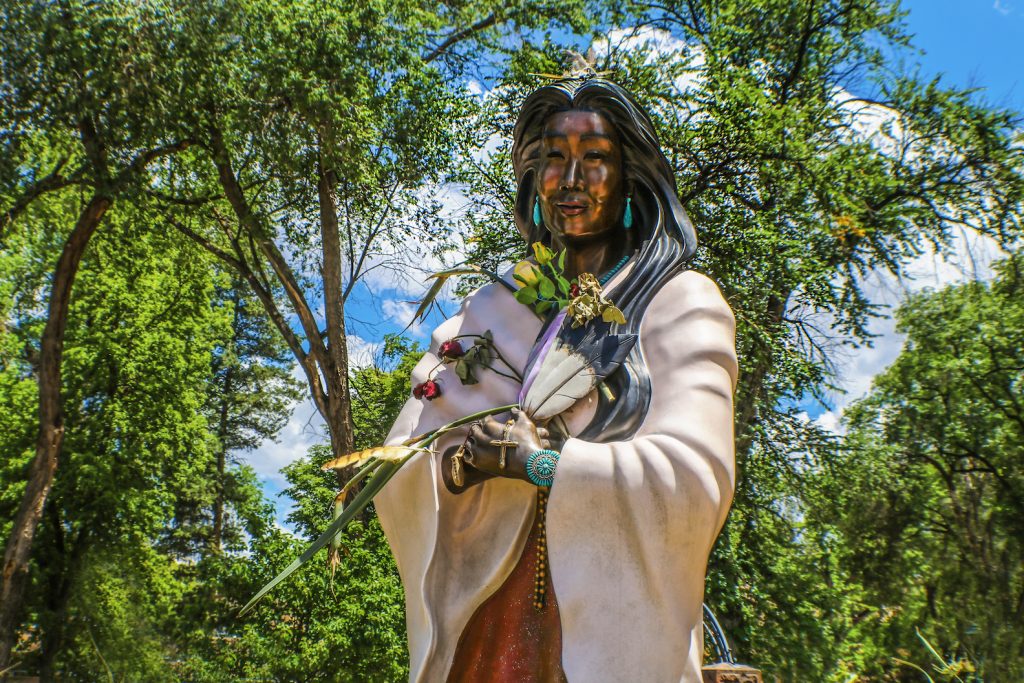“The movements which work revolutions in the world are born out of the dreams and visions in a peasant’s heart on the hillside. For them the earth is not exploitable ground but living mother.” — James Joyce, Ulysses, 1922
I first learned of Bill Jacobs, founder of the Saint Kateri Conservation Center, through a 2021 New York Times article entitled “Meet an Ecologist Who Works for God (and Against Lawns).”
Jacobs lives on a third of an acre in Wading River, New York, on Long Island, and his home is surrounded by “a thicket of flowers, bushes and brambles” that his neighbors have come to see as the bane of their existence.
He’s purposefully planted his yard with flowers, shrubs, and trees, mostly (though not exclusively) native, and allowed them to erupt into a “riot of flora” that provides habitat for migrating birds, butterflies, and bees. His neighbors prefer water-guzzling lawns mowed to military precision and landscaped by Home Depot.
A Catholic, Jacobs maintains that we can fight climate change and help repair the world right from where we live, here and now. But he also believes that “we need something greater than people. … We need a calling outside of ourselves, to some sort of higher power…to preserve life on earth.”
Four years ago, Jacobs teamed with Kathleen Hoenke, another Catholic ecologist. Their goal — to promote wildlife-friendly gardens that also provide a place to pray and meditate — resulted in the Saint Kateri Habitats initiative.
St. Kateri Tekakwitha (1656-1680), “Lily of the Mohawks,” is known as the patroness saint of Native American and First Nations Peoples, integral ecology, and the environment.
She was born in the Kanienkehaka (“Mohawk”) village of Ossernenon and lived much of her life close to what is now the Saint Kateri National Shrine and Historic Site in Fonda, New York. When she was only 4 years old, her mother, father, and baby brother died of smallpox, leaving her scarred, partially blinded, and an orphan.
From a very young age, Kateri had a deep love for the local fields, streams, wildlife, and flora. Influenced by a visiting Jesuit priest, she was baptized at the age of 20 — and thereby became a village outcast. So she walked more than 200 miles to the Catholic mission of St. Francis Xavier at Sault Saint-Louis, near Montreal.
There, she was received into the Church, made a vow of perpetual virginity, was ardently devoted to the Eucharist, and died at 24 — at least partially, it’s believed, from the severe penances to which she subjected herself.
“Kateri would’ve known every plant, would’ve collected food, and would’ve been very connected with the land,” Jacobs said.
Other patron saints of Saint Kateri Habitats include St. Francis of Assisi, St. Thérèse of Lisieux, and Cristina Gaztelu Vargas (1994-2018), a young Spanish woman devoted to nature, art, and helping the poor who died of cancer and whose cause for canonization has been opened.
Saint Kateri Habitats and Parks, an arm of the center, is a ministry that “inspires Catholics and all people of goodwill to restore and manage homes, yards, gardens, parishes, schools, farms, parks, forests, rivers, and wetlands as healthy habitats for people and wildlife.”
The center advocates incorporating a religious element into the landscape, for example, a cross, statue of a saint, shrine, or small altar.
“People have to love the earth before they save it,” Jacobs said. “So love is the key. We don’t do doomsday stuff.”
“It takes a special kind of person to do something like that,” a neighbor sneered, gesturing to Jacobs’ charmingly untamed garden: indeed, it does.
If the earth is to be saved it will be by people who view her as our mother; not by politicians and activists but by “peasants” whose motivation is to give glory to God.
A gardener of the latter breed consents to get her hands dirty, sweat, learn, worry, ache, bleed. That’s what Kateri did when she knelt in the snow to say the rosary, slept on a bed of thorns, even burned herself — all while fervently praying for the conversion of her people.
As “Ben in Florida” commented about Jacobs’ garden: “It might be a joke to some people. Some New Age nonsense. But I grew up walking and playing in the pine forests of North Carolina, and the truth is that nature can be a cathedral in a way that a lawn can never be. Even if you are an atheist, you can implicitly understand that from an aesthetic and scientific viewpoint.”
And even an atheist must be moved by the testimony of those who swore that as St. Kateri breathed her last, her facial scars slowly faded. She was canonized in 2012. Her Jesuit biographer, Father Claude Chauchetière, called her “a holy bee, seeking to gather honey from all sorts of flowers.”

